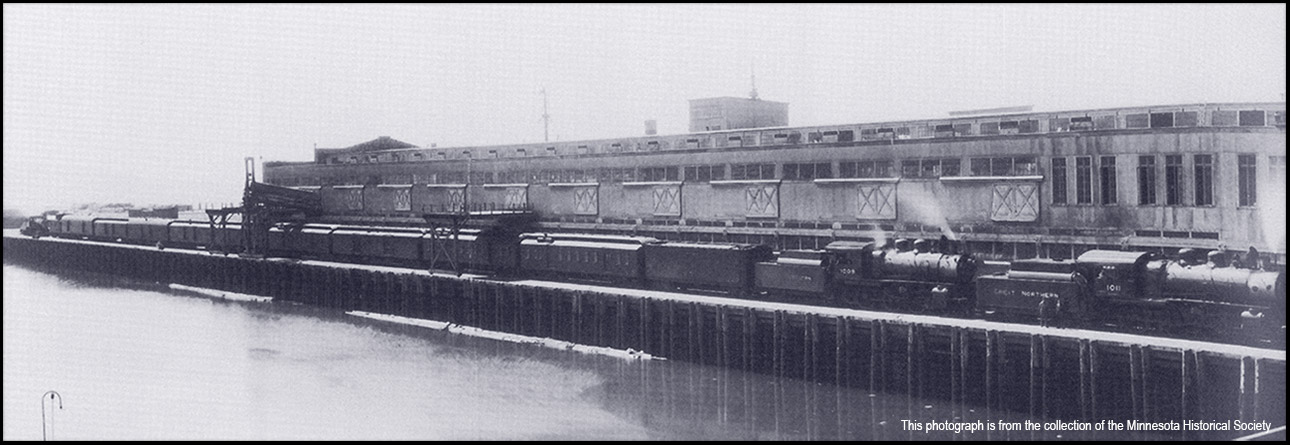
This image was taken in April 1923. It shows the Great Northern Pier 88 at Smith Cove with a silk train ready to leave. You can see the masts of the ship on the other side of the Pier and the grain elevator in the background.
Speed matters
Except for gold and silver bullion, raw silk was the most precious commodity shipped over long distance by commercial carriers. When prices reached a peak of nearly $18 per pound in 1920, a single train's cargo could be worth more than $5 million. Silk was consigned to a New York bank or brokerage house rather than purchased by a manufacturer. Raw silk was traded on the volatile commodities market; therefore, the price could fluctuate considerably in a matter of minutes or hours. A few minutes delay in delivery could mean the loss of thousands of dollars for a firm or speculator. Along with the speculative risk, the cost involved in shipping silk was very high, and insurance against damage, delay and theft was the largest single expense. An hour's delay in delivering a shipment from Yokohama to New York could cost tens of thousands of dollars. Interest charges on the capital borrowed to purchase the silk was also very high. For a shipment of 10,000 bales of silk valued at $10 million, the interest could amount to $1,650 a day. Raw silk was imported duty free so the shipment required a bond. The railroad companies had to furnish the bond which could amount to as much as $2 million per train. There was also risk involved in the delivery, raw silk is susceptible to damage from heat, moisture, fumes or puncture, and while theft of raw silk was primarily limited to the East Coast, it was a major consideration in planning. When these risks and concerns were all added up, speed of delivery mattered. Performance was a big factor in determining which railroads were awarded contracts.
Finally the Silk train shipments and their speed were a huge source of publicity for the railroads. Silk trains were much more than publicity stunts though, pound for pound, silk earned more revenue for the Great Northern Railroad than any other product. Eight times as much per train mile as its crack passenger train, the Oriental Limited.
The Delivery, Yokohama to Seattle
Three major shipping lines dominated the delivery of silk to Seattle, the Admiral Oriental Line (AOL), with its ships named for presidents, the large fast and dependable "535's" were put into service in 1921. From 1922 to 1925 these liners brought in more than $ 300 million worth of raw silk. The two other significant carriers were the Nippon Yusen Kisha (NYK), Japanese Mail Line, and the Osaka Shosen Kaisha. The NYK profited from arrangements with The GN and from its fleet of fast, specially designed, diesel powered ships with "silk rooms" especially constructed to protect the silk bales from damage while crossing the stormy Pacific.
Moving raw silk from Yokohama to Seattle and on to New York involved detailed preparations that were timed to the minute. After a Steamer left Japan, the shipping company cabled its Seattle representative with the ship's estimated arrival time, the number of bales of raw silk, tons of silk goods in the cargo, and the number of the pier at which the ship would dock. Once the vessel came within radio distance of the West Coast, the ship's captain sent the sent the company's port captain a projected time of arrival in Victoria, British Columbia, where ships were held for medical inspection. In Victoria a customs agent from the railroad would board the ship and prepare the paperwork filing for customs entry. Also in the radio message was information about the location of the silk in the ship's hold, so stevedores, train crews, and equipment could be arranged to begin unloading immediately after the ship docked.
Special baggage cars or express refrigerator cars had to be prepared for loading. These cars were carefully inspected by the mechanical department. The cars were jacked up and all the wheels and bearings inspected. Cars had to be cleaned and the steam pipes going through them disconnected, electrical lighting removed, and stoves and projecting appliances were crated to prevent damage to the silk if the load shifted. They were also inspected for the possibility of water leaks. After loading the doors were battened with paper so there could be no possibility of water damage.
The ships would arrive at Smith Cove in Seattle at Great Northern piers 88 and 89 which were connected to the adjoining Interbay Yards in Seattle. As soon as the ship arrives at the dock, the silk is unloaded into sheds on the piers where it undergoes customs inspection. It is inventoried by the Railroad and a record made of which serial numbered bales went into each car.
The Motivation for the Record Run
For sometime the Great Northern had been moving silk between Seattle and St. Paul.on a 56 hour schedule. On July 1924 the rival Northern Pacific (NP) made the same run in 44 hours and 18 minutes, bettering by an hour the GN record set more that twelve years earlier with eight cars of silk. Accepting the challenge, the GN set out to break the new record with a 12 car silk train leaving Seattle on August 2nd of the same year. That run was plagued with problems. There were bearing problems with express car 2063 and at Davenport, North Dakota where the GN and NP tracks crossed, the switches were left in the wrong position and it took 28 minutes to find the switch tower operator. While this run beat the NP record by 63 minutes the difference was not enough to keep the NP from trying again. Extensive preparations began immediately to improve the Great Northern's record.
